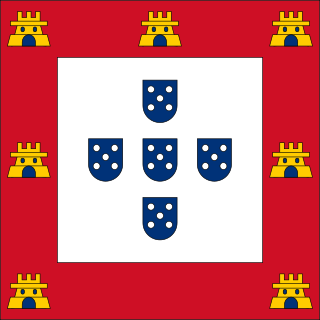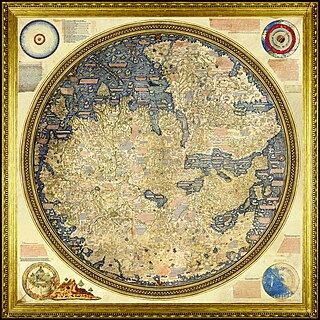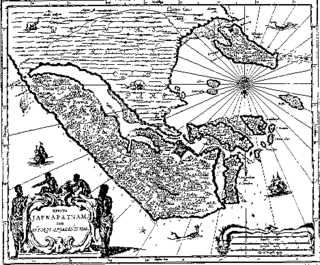Related Research Articles

DomHenrique of Portugal, Duke of Viseu, better known as Prince Henry the Navigator, was a central figure in the early days of the Portuguese Empire and in the 15th-century European maritime discoveries and maritime expansion. Through his administrative direction, he is regarded as the main initiator of what would be known as the Age of Discovery. Henry was the fourth child of the Portuguese King John I, who founded the House of Aviz.

Portugal, officially the Portuguese Republic, is a country whose mainland is located on the Iberian Peninsula of Southwestern Europe, and whose territory also includes the Atlantic archipelagos of the Azores and Madeira. It features the westernmost point in continental Europe, and its Iberian portion is bordered to the west and south by the Atlantic Ocean and to the north and east by Spain, the sole country to have a land border with Portugal. Its two archipelagos form two autonomous regions with their own regional governments. Lisbon is the capital and largest city by population.

The 16th century begins with the Julian year 1501 (MDI) and ends with either the Julian or the Gregorian year 1600 (MDC).

The history of the Kingdom of Portugal from the Illustrious Generation of the early 15th century to the fall of the House of Aviz in the late 16th century has been named the "Portuguese golden age" and the "Portuguese Renaissance". During this period, Portugal was the first European power to begin building a colonial empire as Portuguese sailors and explorers discovered an eastern route to India as well as several Atlantic archipelagos and colonized the African coast and Brazil. They also explored the Indian Ocean and established trading routes throughout most of southern Asia, sending the first direct European maritime trade and diplomatic missions to Ming China and to Japan, at the same time installing trading posts and the most important colony: Portuguese Macau. The Portuguese Renaissance produced a plethora of poets, historians, critics, theologians, and moralists. The Cancioneiro Geral by Garcia de Resende is taken to mark the transition from Old Portuguese to the modern Portuguese language.

The Treaty of Tordesillas, signed in Tordesillas, Spain on 7 June 1494, and authenticated in Setúbal, Portugal, divided the newly discovered lands outside Europe between the Portuguese Empire and the Spanish Empire, along a meridian 370 leagues west of the Cape Verde islands, off the west coast of Africa. That line of demarcation was about halfway between the Cape Verde islands and the islands entered by Christopher Columbus on his first voyage, named in the treaty as Cipangu and Antillia.

Funchal is the largest city, the municipal seat and the capital of Portugal's Autonomous Region of Madeira, bordered by the Atlantic Ocean. The city has a population of 105,795, making it the sixth largest city in Portugal. Because of its high cultural and historical value, Funchal is one of Portugal's main tourist attractions; it is also popular as a destination for New Year's Eve, and it is the leading Portuguese port on cruise liner dockings.

Conquistadors or conquistadores were the explorer-soldiers of the Spanish and Portuguese Empires of the 15th and 16th centuries. During the Age of Discovery, conquistadors sailed beyond Europe to the Americas, Oceania, Africa, and Asia, colonizing and opening trade routes. They brought much of the Americas under the dominion of Spain and Portugal.

São Luís is the capital and largest city of the Brazilian state of Maranhão. The city is located on Upaon-açu Island or Ilha de São Luís, in the Baía de São Marcos, an extension of the Atlantic Ocean which forms the estuary of Pindaré, Mearim, Itapecuru and other rivers. Its coordinates are 2.53° south, 44.30° west. São Luís has the second largest maritime extension within Brazilian states. Its maritime extension is 640 km. The city proper has a population of some 1,108,975 people. The metropolitan area totals 1,605,305, ranked as the 15th largest in Brazil.

Faro is a municipality, the southernmost city and capital of the district of the same name, in the Algarve region of southern Portugal. With an estimated population of 60,995 inhabitants in 2019, the municipality covers an area of about 202.57 km2 (78.21 sq mi).

The Age of Discovery, also known as the early modern period, was a period largely overlapping with the Age of Sail, approximately from the 15th century to the 17th century in European history, during which seafaring Europeans explored and colonized regions across the globe.
João Fernandes Lavrador (1453-1501) was a Portuguese explorer of the late 15th century. He was one of the first modern explorers of the Northeast coasts of North America, including the large Labrador peninsula, which was named after him by European settlers in eastern Canada. The popular dog breed Labrador Retriever is named after the peninsula and thus by effect also bears his name. It was developed as a working breed for hunting.

Faial Island, also known in English as Fayal, is a Portuguese island of the Central Group of the Azores. The Capelinhos Volcano, the westernmost point of the island, may be considered the westernmost point of Europe, if the Monchique Islet, near Flores Island, is considered part of North America, for it sits on the North American Plate. Its largest town is Horta.

Inter caetera was a papal bull issued by Pope Alexander VI on the 4 May 1493, which granted to the Catholic Monarchs King Ferdinand II of Aragon and Queen Isabella I of Castile all lands to the "west and south" of a pole-to-pole line 100 leagues west and south of any of the islands of the Azores or the Cape Verde islands.

The geography of North Africa has been reasonably well known among Europeans since classical antiquity in Greco-Roman geography. Northwest Africa was known as either Libya or Africa, while Egypt was considered part of Asia.

This is a chronology of the early European exploration of Asia.

The Catholic Church during the Age of Discovery inaugurated a major effort to spread Christianity in the New World and to convert the indigenous peoples of the Americas and other indigenous peoples. The evangelical effort was a major part of, and a justification for, the military conquests of European powers such as Portugal, Spain, and France. Christian missions to the indigenous peoples ran hand-in-hand with the colonial efforts of Catholic nations. In the Americas and other colonies in Asia, and Africa, most missions were run by religious orders such as the Franciscans, Dominicans, Augustinians, and Jesuits. In Mexico, the early systematic evangelization by mendicants came to be known as the "Spiritual Conquest of Mexico".

The first European colonization wave began with Castilian and Portuguese conquests and explorations, and primarily involved the European colonization of the Americas, though it also included the establishment of European colonies in India and in Maritime Southeast Asia. During this period, European interests in Africa primarily focused on the establishment of trading posts there, particularly for the African slave trade. The wave ended with the British annexation of the Kingdom of Kandy in 1815 and the founding of the colony of Singapore in 1819.

Portuguese maritime exploration resulted in the numerous territories and maritime routes recorded by the Portuguese as a result of their intensive maritime journeys during the 15th and 16th centuries. Portuguese sailors were at the vanguard of European exploration, chronicling and mapping the coasts of Africa and Asia, then known as the East Indies, and Canada and Brazil, in what came to be known as the Age of Discovery.

The Portuguese conquest of the Jaffna kingdom occurred after Portuguese traders arrived at the rival Kotte Kingdom in the southwest of modern Sri Lanka in 1505. Many kings of Jaffna, such as Cankili I, initially confronted the Portuguese in their attempts at converting the locals to Roman Catholicism, but eventually made peace with them.

The British Ceylon period is the history of Sri Lanka between 1815 and 1948. It follows the fall of the Kandyan Kingdom into the hands of the British Empire. It ended over 2300 years of Sinhalese monarchy rule on the island. The British rule on the island lasted until 1948 when the country regained independence following the Sri Lankan independence movement.
References
- 1 2 3 Grun, Bernard (1991). The Timetables of History (3rd ed.). New York: Simon & Schuster. p. 229. ISBN 0-671-74919-6.